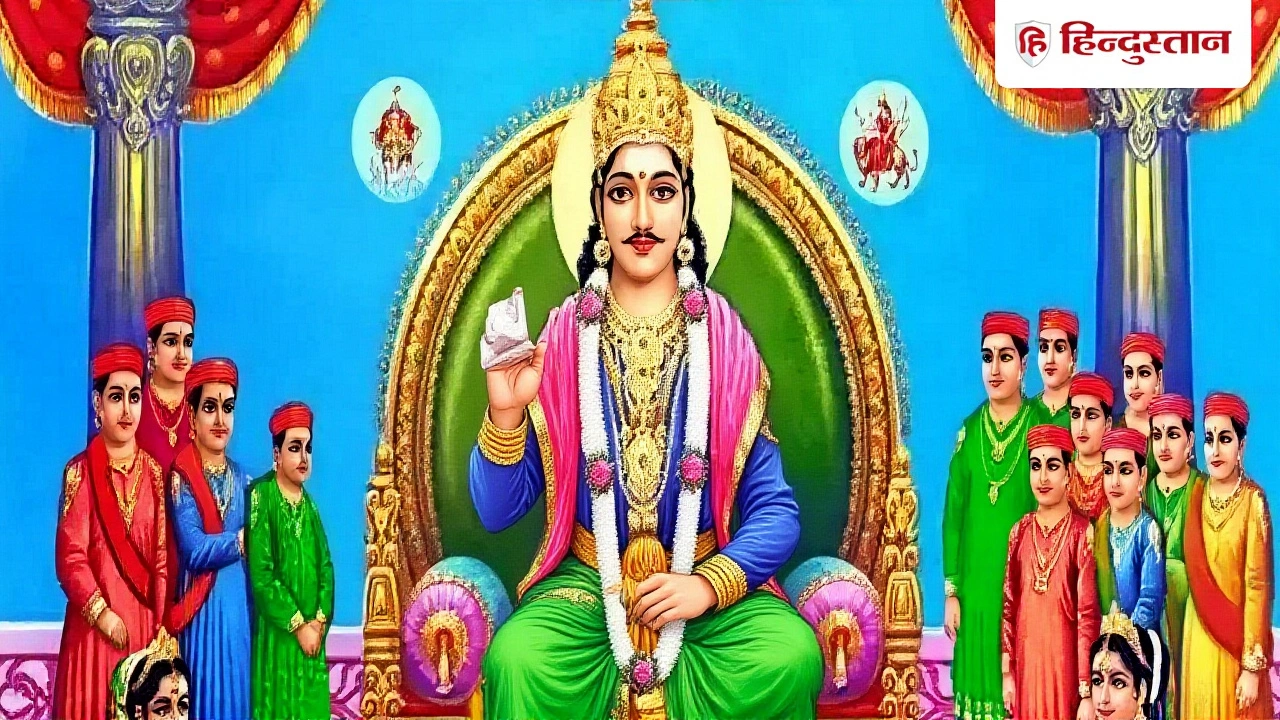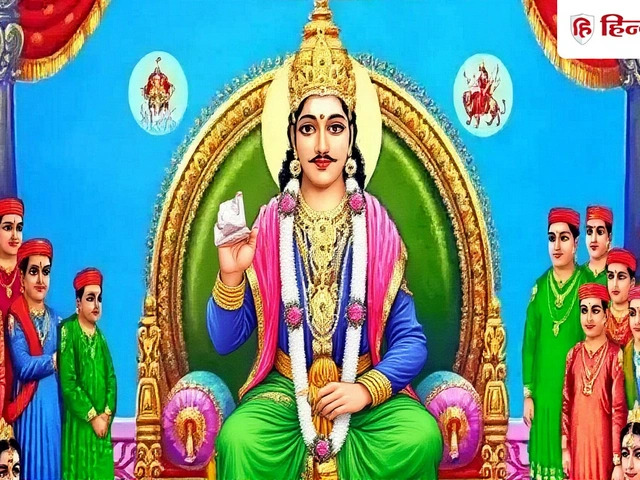Chitragupta Puja 2025: Kayastha Community Marks Auspicious Day on Oct 23
When Lord Chitragupta, the Hindu deity known as the divine accountant, is honored on October 23, 2025, millions of devotees across India pause to reflect on honesty, record‑keeping and the power of knowledge.
The celebration, widely called Chitragupta Puja, falls on the second day of the bright fortnight (Shukla Paksha Dwitiya) of Kartik, a day that also aligns with Bhai Dooj and the aftermath of Diwali. In the capital city of New Delhi, the ritual window opens at 8:16 PM on October 22 and closes at 10:46 PM on October 23, according to the religious desk of Prabhat Khabar.<\/p>
Background and Significance
The Chitragupta PujaIndia has long been a cornerstone for the Kayastha community, a social group traditionally tasked with record‑keeping, administration and bookkeeping. Because the deity is believed to maintain an immaculate ledger of every soul’s deeds, Kayasthas view him as both protector and patron of their professional lives.
Historically, the community has performed the ritual to seek blessings for accuracy in accounts, success in examinations, and fairness in judicial matters. The practice dates back to ancient Vedic texts, where Chitragupta is described as the son of Lord Brahma, appointed to balance karma by noting each action.
Auspicious Timings and Ritual Details
Three distinct muhurats (auspicious periods) have been highlighted by major media outlets:
- News18 quotes astrologer Dr. Jha, who recommends the Ati Uttam Muhurat from 8:16 AM to 10:33 AM IST, followed by the Uttam Muhurat until 12:38 PM.
- Prabhat Khabar lists the Aparahna Muhurat as 12:53 PM–3:09 PM IST, a window lasting exactly 2 hours 16 minutes.
- Jagran notes a slightly different slot: 1:13 PM–3:28 PM IST.
Regardless of the exact timing, the core steps remain the same: devotees rise early, bathe, and dress in clean garments before setting up an altar. An idol or picture of Lord Chitragupta is placed at the centre, surrounded by offerings of pens, inkpots, account books, notebooks and any paper used in study or business—collectively called the ‘Kalam‑Dawat’ (pen‑feast).
Community Practices and Symbolic Offerings
Families gather around the altar, lighting incense and offering aarti while chanting a mantra 108 times—a practice highlighted in the Live Hindustan report. The mantra, though not printed in most articles, is believed to invoke the deity’s blessings for wisdom, intellect and justice.
After the recitation, participants place pens, pencils, registers, and even laptop keyboards at the deity’s feet, symbolising surrender of all tools of documentation to the divine accountant. This act reflects a profound respect for knowledge and the written word, echoing the community’s historic role as custodians of legal and fiscal records.
Children are encouraged to participate, hoping that the ritual will bless their academic pursuits. Meanwhile, entrepreneurs and accountants seek a year free of clerical errors, hoping the deity’s ledger will keep their own ledgers clean.
Expert Perspectives and Media Coverage
Veteran journalist Amit Ranjan, writing for News18, described the puja as a “spiritual audit” that reminds practitioners to act with integrity. He noted that the event draws attention not just from the Kayastha community but also from students, teachers, and government clerks who see the ritual as a morale booster before the new fiscal year.
Astrologer Dr. Jha explained that the chosen muhurats align with the moon’s ascent in the sign of Libra, a period traditionally linked to balance and fairness—qualities embodied by Lord Chitragupta.
The collective reporting from Prabhat Khabar, Jagran and News18 underscores the event’s growing visibility beyond regional boundaries, especially as diaspora communities in the United Kingdom and the United States begin to observe the day via virtual pujas.
What the Observance Means Today
In a world where digital records replace paper ledgers, the symbolism of worshipping pens and books takes on a new resonance. For many, it’s a reminder that behind every byte of data lies a human responsibility to record truthfully.
Social media platforms are buzzing with photos of colourful altars, handwritten notes of gratitude, and livestreams of the aarti. Influencers from the education sector share study‑tips alongside clips of the ritual, linking academic diligence with divine blessing.
The intersection of tradition and technology is evident when accounting firms sponsor virtual ‘Kalam‑Dawat’ sessions, encouraging employees to pause their spreadsheets and join a collective chant.
Looking Ahead: Future of the Festival
As younger generations reinterpret the ritual, experts anticipate a shift toward eco‑friendly offerings—recycled paper, biodegradable pens, and digital certificates of gratitude. Still, the core intention—to seek honesty in one’s deeds—remains unchanged.
With the government’s push for financial literacy, some state education boards are considering incorporating a brief lesson on Lord Chitragupta’s myth during school assemblies in October, framing the story as a moral lesson on accountability.
No matter how the format evolves, the day will continue to serve as an annual checkpoint, reminding individuals and institutions alike to audit not just numbers, but intentions.
Key Facts
- Date: Thursday, 23 October 2025
- Primary deity: Lord Chitragupta
- Key community: Kayastha
- Major muhurats: 8:16 AM–10:33 AM (Ati Uttam), 12:53 PM–3:09 PM (Aparahna), 1:13 PM–3:28 PM (Jagran)
- Symbolic offerings: pens, inkpots, books, account ledgers
Frequently Asked Questions
Why is Chitragupta especially important to the Kayastha community?
Kayasthas have historically served as scribes, accountants and administrators. Since Lord Chitragupta is believed to keep an eternal record of every soul’s deeds, the community venerates him as their patron, seeking his guidance for accuracy in both professional and personal matters.
What are the recommended timings for the puja this year?
Astrologer Dr. Jha advises the Ati Uttam Muhurat from 8:16 AM to 10:33 AM IST, followed by the Uttam Muhurat until 12:38 PM. Newspapers Prabhat Khabar and Jagran list afternoon windows of 12:53 PM–3:09 PM and 1:13 PM–3:28 PM respectively, giving devotees flexibility based on regional calendars.
What items are traditionally offered during the ceremony?
The ritual, called Kalam‑Dawat, involves placing pens, pencils, inkpots, notebooks, account books and any paper used for study or business at the deity’s feet. These items symbolize knowledge, documentation and the tools of the Kayastha trade.
How is the chant of 108 mantras performed?
Devotees repeat a specific mantra dedicated to Lord Chitragupta exactly 108 times, often using a mala (prayer beads) to keep count. While the exact wording varies among regional traditions, the repetition is meant to invoke his blessings for wisdom and integrity.
Will the puja be observed outside India?
Yes. Diaspora groups in the United Kingdom, United States, and Canada have begun hosting virtual Chitragupta Puja sessions, streaming the aarti and allowing participants to offer prayers from abroad.






